
Switzerland - Transports publics neuchâtelois transN
For a full scale picture, please click on the picture shown !
Le Locle–Les Brenets line
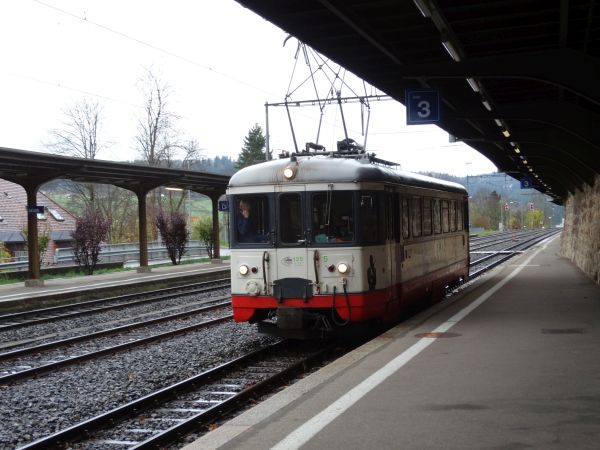
The Le Locle to Les Brenets railway is a short metre gauge line elctrified with 1500V DC. The whole railroad is just 4,1 km long
and during recent years the only train actively running on the line has been this motor wagon BDe 4/4 no.5. There is no metre gauge
connection to anywhere else, this short line is totally isolated. The line begins at the station of La Locle, a small station
located along the main line from La Chaux des Fonds in Switzerland through to France. The station isn't located at the town of La Locle,
but rather high up on a hillside well uphill from the town. There are normal gauge, normal trains coming to Le Locle regularly both
from La Chaux des Fonds and also from France, so there's a connecting train to both directions here every hour. The station of Le Locle
is 946 metres above sea level. This small railroad descents from there to Les Brenets, which is 873 m above sea level. There's not
much there at Les Brenets, mainly just a famous outdoors and picnic site with a large forest and hiking routes. The line was originally
built by the Régional des Brenets and opened on 1 September 1890. Currently the small train on the small line is operated by transN,
the cantonal traffic company of canton Neuchâtel. But the canton has already long ago made a decision to close this railroad and
replace this train by electric small buses. They are threatening to close the line in 2024 and railroad fans are opposing and protesting.
Picture from Le Locle 4.11.2022 by Ilkka Siissalo.
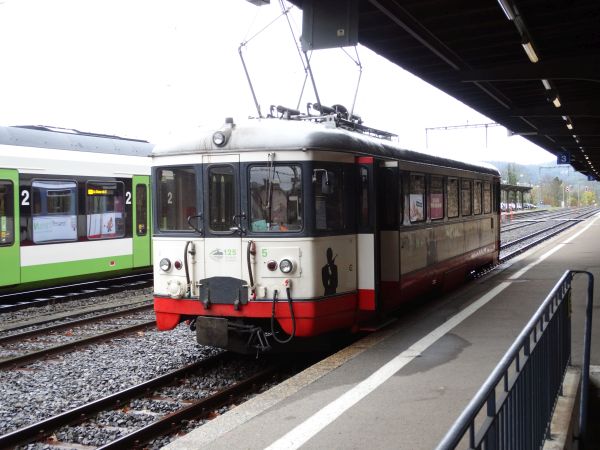
This BDe 4/4 no.5 is one of the series BDe 4/4 1 to 5, all built in 1950 by the companies Reggiane, SAAS and TIBB. They had to be built
in Italy as the Swiss owners of the small railroad did not otherwise have enough money. They were all built
for 1,5 kV DC, metre gauge and they were used on two of the small lines that are all now a part of transN. These motor wagons are
11,85 metres long and have a top speed of 60 km/h. Number 1 was already in 1997 dismantled and its undercarriage was reused to build
a panorama steering wagon, which has been used with the locomotives of CJ, the Chemins de Fer du Jura. All of these trains and their
individual steering cab coaches used to be dark red with just one white stripe.
Picture from Le Locle 4.11.2022 by Ilkka Siissalo.
The former Chemin de Fer des Montagnes Neuchâtelois CMN
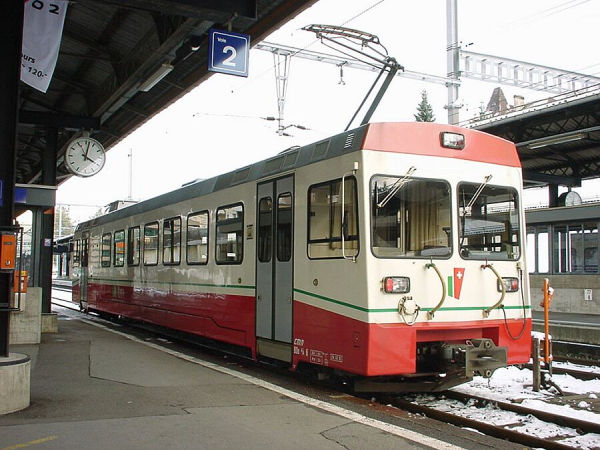
transN was established in 2012 by combining together several individual companies running
public transport services in the area around the city of Neuchâtel and the city of La Chaux de Fonds. One of these smaller
companies which was fused into transN was the Chemin de Fer des Montagnes Neuchâtelois CMN. CMN in turn had been formed in
1947 by fusing together two very small rail companies: Le Régional des Brenets, RdB and Ponts-Sagne-Chaux de Fonds, PSC.
CMN operated the two lines formerly run by these individual companies. The lines are Le Locle - Les Brenets (4,1km, opened in
1890) and Les Ponts-de-Martel - La Chaux-de-Fonds: (16,2km, opened in 1889.)
In 2001 CMN had three old (from 1950) and three modern one coach electric motor units. This one, no. 6, was the first of the newer
series, built in 1991. It is 20,70 m long, weighs 35,5 tons, has a maximum speed of 80 km/h and operates on 1 meter gauge
tracks with 1500 V DC.
Photo of CMN BDe 4/4 no.6 from La Chaux de Fonds station at 1. Nov. 2001 by Ilkka Siissalo.
Normal gauge trains of transN
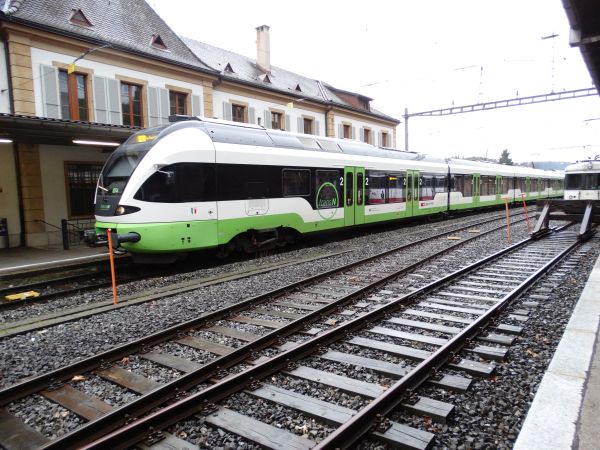
transN operates also normal gauge trains using Stadler FLIRT trains in cooperation with SBB. This is the line 223 Neuchâtel -
La Chaux-de-Fonds - Le Locle. There is also another line 221 Neuchâtel - Buttes. Altogether transN has seven FLIRT units.
Here we see a meeting of trains at Le Locle. The FLIRT train from Neuchâtel, the small train from Les Brenets and the French
SNCF's X76500 class diesel railbuses called autorail à grande capacité all meet at Le Locle once per hour.
Picture from Le Locle 4.11.2022 by Ilkka Siissalo.
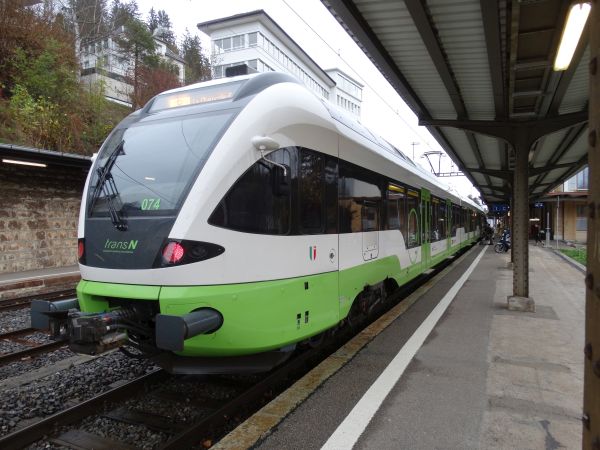
A closer look at the RABe523 FLIRT EMU of transN.
Picture from Le Locle 4.11.2022 by Ilkka Siissalo.
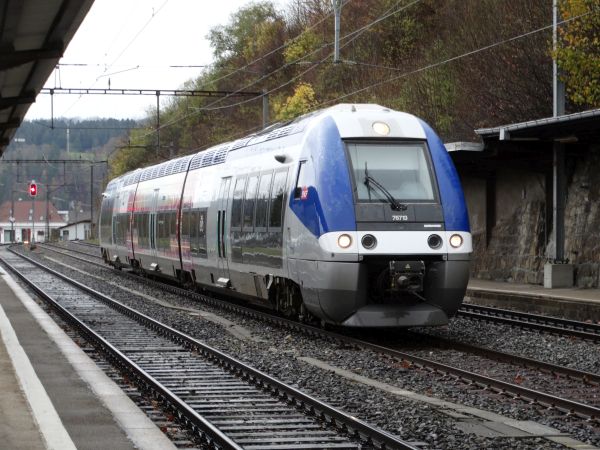
This is not a transN train but a French SNCF class X76500 diesel railbus, but it is operating over the border to Le Locle by
an agreement with transN. It operates between Le Locle and Besançon.
Picture from Le Locle 4.11.2022 by Ilkka Siissalo.
transN trams
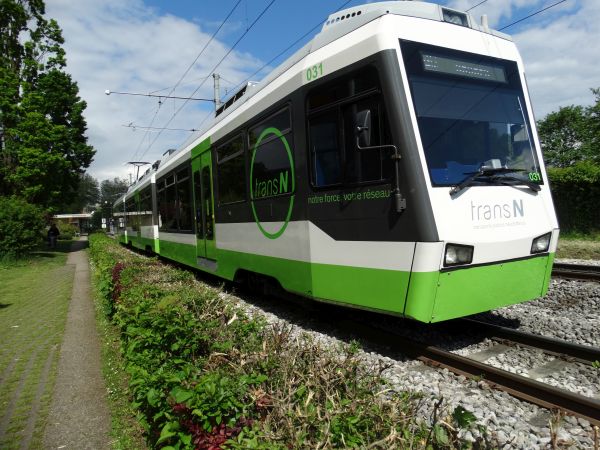
transN operates one tram line along the shores of the lake Neuchâtel. It is an 8,8 km long line opened already in 1892. There is
just one line with 12 stops from Neuchâtel to Boudry. Formerly there were seven different tram lines in Neuchâtel, but this is
the only one left.
transN was in 2019 able to buy from the city of St Gallen, from Appenzeller Bahnen these tram-trains of the type Be 4/8 which
run on the line currently. They had been bought for the Trogenerbahn route in St Gallen, but since in St Gallen the overhead
catenary voltage was changed, AB could not use them any more. At the time when transN bought these tram-trains they were only
11 years old, which is a relatively young age for a tram.
Picture from the tram stop Auvernier Littorail 12.5.2023 by Ilkka Siissalo.
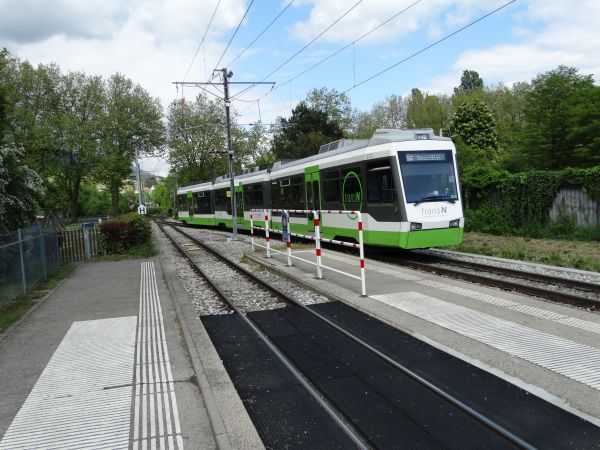
It's a bit difficult to define if these wagons should be called trams or trains. The line in Neuchâtel is clearly a tram line, but
these trains were built for the Trogenerbahn route which is still officially a train route. Anyway, they serve transN now quite nicely.
Picture from the tram stop Auvernier Littorail 12.5.2023 by Ilkka Siissalo.
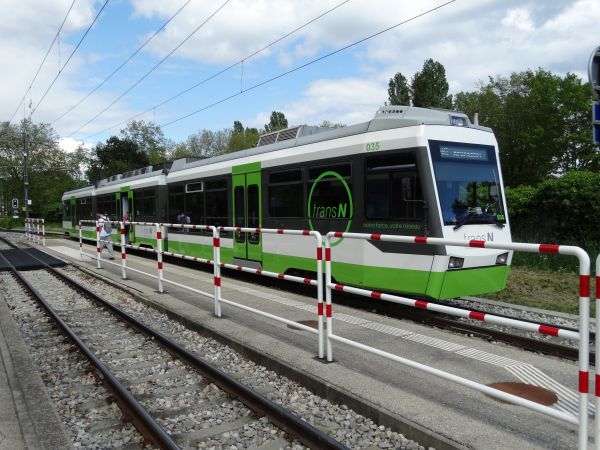
These newer tram-trains of the type BDe 4/8 (or Be 4/8 as they were called at the Trogenerbahn) were built 2004-2008. They are 36,3 metres long
and have a top speed of 80 km/h and a power rating of 432 kW. transN has five of these tram-trains. Each train can theoretically take up to 259 passengers.
Picture from the tram stop Auvernier Littorail 12.5.2023 by Ilkka Siissalo.
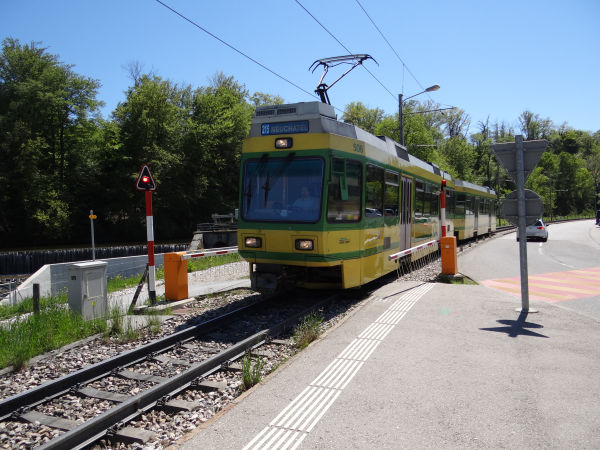
For a long time, 38 years, this tram line was served by trams of the type Be 4/4 (numbers 501 to 506) and four similar
unmotorised steering cab coaches (no.551-554). They were from 1981 (no.505-506 from 1988). They have all been retired by now.
Here we see the motor wagon 506 and the steering cab wagon 554 at Pervou 5.5.2016. Picture by Ilkka Siissalo.
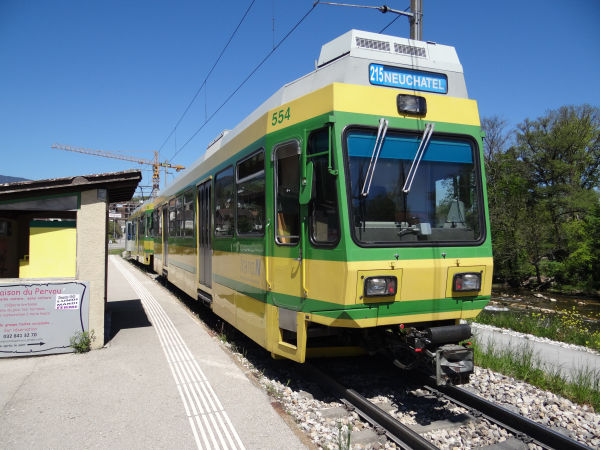
This is the other end of the same tram-train as seen above. The unmotorised steering cab coach 554 was very similar to the motor
wagon but was missing its pantograph and the electric motors.
The steering cab wagon 554 at Pervou 5.5.2016. Picture by Ilkka Siissalo.
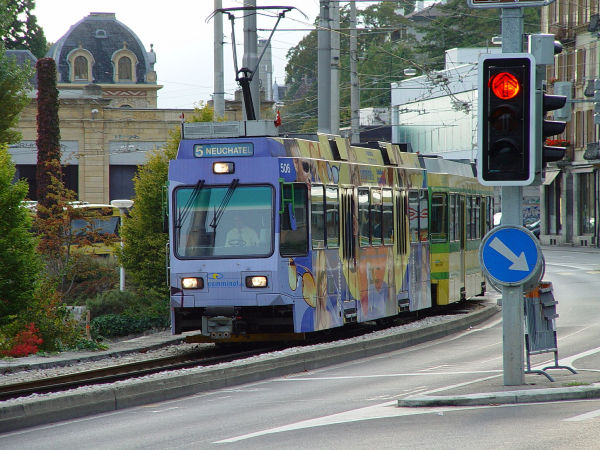
In 2002 the same motor wagon no.506 was still fully covered by advertisement tapings.
Picture from Neuchâtel Place Pury 5.10.2002 by Ilkka Siissalo.
transN funiculars
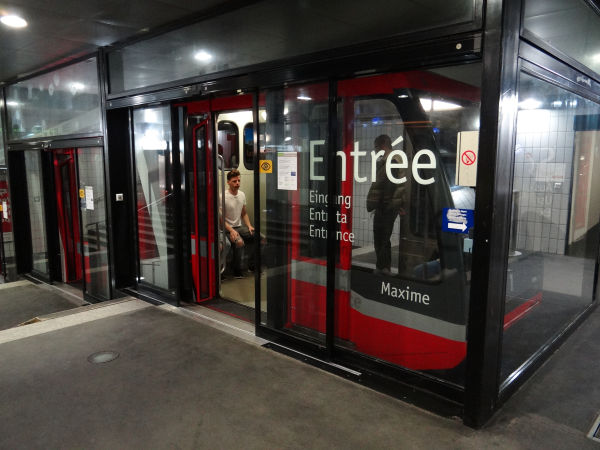
transN operates also several funicular lines. This one is the fully automated funicular called Fun'ambule, which links Neuchâtel's
railway station with the university campus. It was opened for public use in 2001.
Picture from Neuchâtel railway station 5.5.2016 by Ilkka Siissalo.
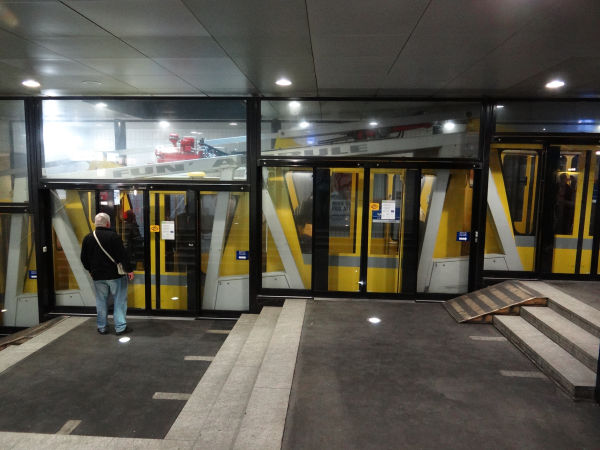
The other train of the Fun'ambule funicular is yellow. The construction of the train is highly unusual. A large capacity is needed,
so the trains are quite long. But since the hill slope is very steep and the gradient is changing abruptly, the train is composed of
several very small pieces attached together with exotic looking hinges.
Picture from Neuchâtel railway station 5.5.2016 by Ilkka Siissalo.

